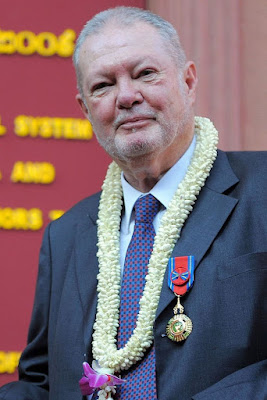Documenting the dirty side of the international art market. @artcrime2
Wednesday, October 6, 2021
The Pandora Papers Leak Reveals How the Late Dealer Douglas Latchford Used Offshore Accounts to Sell Looted Cambodian Antiquities
More revelations are likely forthcoming as journalists comb through the leak.
Sarah Cascone, October 5, 2021
A bronze decoration from a late 12th century boat from Douglas Latchford's collection being repatriated to Cambodia. Photo by Matthew Hollow, courtesy of the Royal Government of Cambodia.
The Pandora Papers, a trove of 11.9 million documents leaked on Sunday, are revealing the shadowy business dealings of some the world’s wealthiest and most powerful people. Among the prominent names from the art world to emerge is that of late antiquities dealer Douglas Latchford, a leading Cambodian art scholar who, the papers show, used offshore trusts to sell looted art.
In 2019, just months before his death, the U.S. Attorney’s Office in the Southern District of New York had charged Latchford with trafficking Cambodian antiquities. He was accused of falsifying invoices, provenance documents, and shipping information to smuggle illicitly obtained artworks internationally.
When authorities got wind of Latchford’s shady dealings, it appears he attempted to better conceal his transactions by establishing trusts in tax havens, reports the Washington Post. (The newspaper is planning a series of articles detailing further contents of the leak.)
In February, Latchford’s daughter, Nawapan Kriangsak (formerly Julia Ellen Latchford Copleston), announced that her father’s $50 million collection of Khmer antiquities would be repatriated to Cambodia. The 125 pieces were considered the most important collection of ancient Cambodian art in private hands, although many were suspected of having been stolen.
British Khmer art collector Douglas Latchford during a function at the National Museum of Cambodia in Phnom Penh on June 12, 2009. Latchford, a well known collector of Khmer art, repatriated a number of Khmer antiquities during the event. Photo by Tang Chhin Sothy/AFP via Getty Images.
Some of the world’s leading museums are now coming under increased scrutiny over works in their collections that were once owned by the late collector. The Denver Art Museum has six, the British Museum has five, the Cleveland Museum of Art has three, and the Metropolitan Museum of Art has 12 pieces that list Latchford in the provenance, if not as the donor outright.
In 2013, the Met previously repatriated to Cambodia a pair of statues partially gifted by Latchford. Known as the “Kneeling Attendants,” the figures had been looted from the Koh Ker temple complex.
In light of the new revelations, the museum is now “reviewing the pieces that came to the Met’s collection via Latchford and his associates,” a spokesperson for the museum told Hyperallergic. “As we continue our research, we will engage with the government of Cambodia as needed, as we have had a strong and productive partnership with their cultural leaders in the past.”
In terms of the volume of data (2.9 terabytes, to be precise), the Pandora Papers are the largest offshore finance leak in history, exceeding the 11.5 million documents in the Panama Papers, published in April 2016, and the 1.4 terabytes of data in the Paradise Papers in 2017.
The International Consortium of Investigative Journalists in Washington, D.C., obtained the Pandora Papers data from an unidentified source. The documents from 14 firms linked to secret offshore accounts belong to billionaires, celebrities, world leaders, and powerful companies.
Early estimates suggest that up to $32 trillion in funds are being moved through offshore financial channels to avoid taxation—and that’s not counting non-monetary assets such as art and real estate.
Among the other names associated with the art world is Helena de Chair, wife of British conservative party politician Jacob Rees-Mogg, whose holding company is the beneficiary of a trust that owns “pictures and paintings” worth $3.5 million.
Jacques-Louis David, The Anger of Achilles (1819). Collection of the Kimbell Art Museum, Fort Worth, Texas. The Pandora Papers reveal that a second version of the work belongs to Konstantin Ernst, a Russian film producer and head of the Russian TV network Channel One who works closely with Russian president Vladimir Putin.
Then there is Konstantin Ernst, head of the Russian TV network Channel One who is widely credited for managing Vladimir Putin’s image. According to the Pandora Papers, Ernst owns one of two versions of the Jacques-Louis David oil painting The Anger of Achilles through an offshore company. The other copy of the work is in the collection of the Kimbell Art Museum in Fort Worth, Texas. Ernst’s painting is worth $6.2 million, according to data reviewed by the ICIJ.
Works by Pablo Picasso and Banksy are also named in some of the documents, according to the Guardian.
“This is the Panama papers on steroids,” Gerard Ryle, director of the International Consortium of Investigative Journalists, told the Guardian. “It’s broader, richer and has more detail.”
https://news.artnet.com/art-world/pandora-papers-douglas-latchford-2017069?utm_content=from_&utm_source=Sailthru&utm_medium=email&utm_campaign=10%2F6%20AM%20US&utm_term=US%20Daily%20Newsletter%20%5BMORNING%5D
Subscribe to:
Post Comments (Atom)



No comments:
Post a Comment